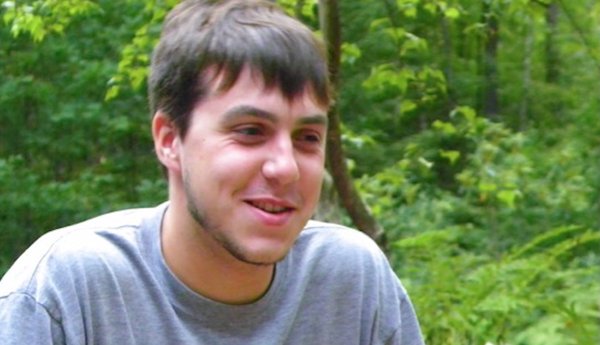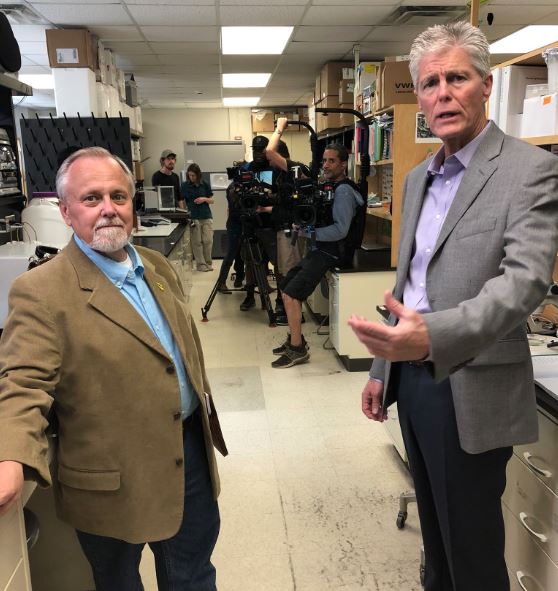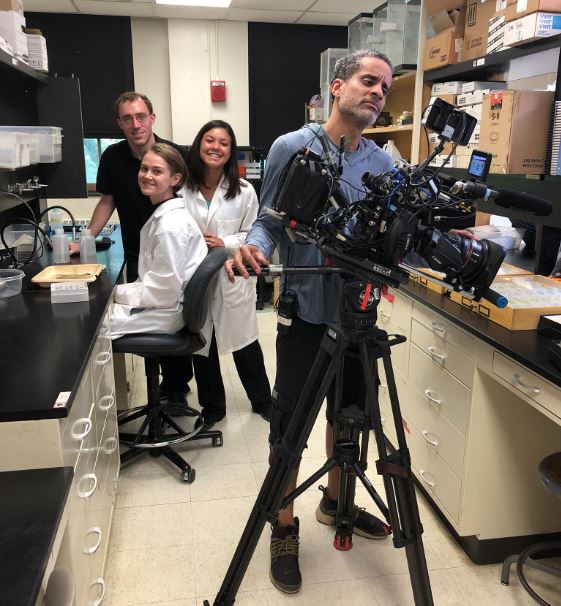Retired NYPD detective Kevin Gannon and his team of Smiley Face killer theory investigators aren’t primarily trying to prove who did it on the new Oxygen series, Smiley Face Killers: The Hunt For Justice. Rather, they’re trying to prove that homicide happened in the first place so authorities launch an investigation into suspects.
However, Heavy interviewed Gannon on January 25, 2019 to ask him more about the “who.” In other words, if there is a smiley face gang systematically murdering young men throughout the country, as the investigators claim, that would obviously be a massive story. How do they operate? Where? Why? Do they have a name? Read on.
Gannon told Heavy that the investigators think it’s possible that the killers pick the victims in advance, perhaps by searching for people who fit the right background (good athletes and students) on social media. In fact, they believe the abductions occur with “military precision.”
Gannon said the killers may see on social media that someone is a “star football kid. They even know which dorm. They sit outside and watch them. I believe it’s not just random engaging in conversation in a bar. It’s military precision. They have to have some kind of military background. There’s surveillance and counter-surveillance.”
The Oxygen series and its investigators selected six of the most suspicious cases to highlight on the series in a quest to prove to the public that the young men featured in them were victims of homicide. In most cases, local authorities have written off drowning deaths of young men around the United States in rivers and lakes as undetermined cause or accidental drownings due to alcohol. The theory definitely has its skeptics, and it remains unproven.

FacebookDakota James
That’s not true in all cases, though. For example, in Minneapolis, the death of Wisconsin-raised college student Chris Jenkins – who was found in the Mississippi River in a Halloween costume after a night out – was not ruled a homicide for years until authorities suddenly did an about face and said he was the victim of one. Oxygen is not focusing on the Jenkins’ case, but Gannon did discuss it with Heavy. In the first case showcased by Oxygen – the death of Dakota James in Pennsylvania – Gannon and his team raised significant and good questions about whether he died from homicide when famed pathologist Cyril Wecht reviewed the never-before-seen (by the family, investigators and the public at any rate) autopsy photos and found marks on James’ neck are “strongly suggestive of and entirely consistent with a ligature having been applied around the neck. This death may have been due to ligature strangulation.”
The FBI has in the past thrown cold water on the idea that an organized gang of smiley face killers is committing serial murder of young, preppy, athletic, handsome and intelligent men throughout the United States and especially in the Midwest. The victims, typically in their 20s, and typically Caucasian, vanish after nights out in bars with friends, only to turn up deceased in rivers or lakes, in some cases under more suspicious circumstances than in others. The investigators claim the killers left scrawled smiley faces at some of the scenes. The smiley face serial killer theory is a decade-old theory pushed by the group of retired law enforcement officers and a Minnesota college professor.
The FBI looked at the cases in 2008 and released a statement that there was no evidence to support the smiley face serial killer theory. Instead, wrote the FBI, the cases appeared to be “alcohol-related drownings.” That statement was released before some, but not all, of the cases featured in the Oxygen series.
The Oxygen series’ first episode premiered on January 19, 2019 at 7 p.m. ET/PT. The deaths featured on the Oxygen channel show are those of Dakota James of Pennsylvania; of Tommy Booth, also in Pennsylvania; of Lucas Homan in Wisconsin; of Todd Geib in Michigan; of William Hurley in Massachusetts; and of Brian Welzien in Illinois. James was the subject of episode one. You can see videos and more details relating to that case here on the Oxygen Channel’s website.
“For us the ultimate goal is we have to prove homicide first,” Gannon told Heavy.
Here’s what Gannon told Heavy about the gang the group thinks is committing murders:
How many deaths do they think are connected?
“If you look at the demographics and type of individuals, there are well over 350 cases” of young men drowning in a similar fashion, throughout the country, Gannon said. Of those, he said, “The ones we can connect are just over 100.”
How did they connect them?
The team of investigators went to scenes and did their own investigations, Gannon said. In addition to the similarities in how the men are found and their backgrounds, Gannon said the investigators “identified gang graffiti” that link the deaths. Among those: The rudimentary smile faces they’ve found near some scenes.
“It’s more comprehensive than the smiley face. We have 12 other distinct symbols,” he said. “Two are really related to the ideology.”
He said that in particular two of the symbols are “very specific,” but he wouldn’t describe them or the referenced ideology. He said the investigative team would reveal them to law enforcement. He said they don’t want to incite copy cat killings by releasing the symbols to the media.
“There has to be a lot more for us even to prove homicide,” he said, adding that the men have taken thousands of photos at scenes and stressing again that they have found “distinct symbols.” They also review autopsy and police records when available. They have studied where they think the men were most likely to go into the water.
“We went out in the field,” he said.
“Even with knowing it’s probably connected, I won’t say homicide until I get all the paperwork, photos, to see if it’s really a homicide,” he said.
How are the men abducted?
Gannon alleged that most of the men are drugged. “The majority of our victims do have GHB in their bodies,” he said. “That’s the date rape drug, and 30-40 victims have it.”
He stressed: “Some medical examiners say that is naturally occurring in deceased bodies. That can be true.” However, he said that’s usually going to be at a low level, and some of the victims on their list have levels much higher.
How many people are in the smiley face killers gang?
“It could be a thousand or more,” said Gannon. “They are a well-structured, organized gang with cells in major cities in the United States.”
He said some cells have 12-15 people in a city. “We know where the cells exist. We know the area.”
Where is this gang located?
He said the cells exist in multiple states, but most are focused on the upper Midwest. In Wisconsin, Gannon said, “La Crosse and the Eau Claire area are really big. North by Sheboygan.”
He claimed there is a cell in Michigan. “One is definitely in East Lansing, Michigan,” he said, adding that there might be a cell in Grand Rapids too.
“We have a group in Chicago,” he said, adding that “a lot of the victims in Chicago have been from other cities where we have cells.” For example, he said, “one kid in Chicago for a weekend came from East Lansing.”
He said other areas with cell are Minneapolis, Minnesota, Indiana, and Iowa. “The upper Midwest area.”
What is the name of the group?
Gannon declined to reveal that information but says the investigators know it.
Why haven’t the gang members given each other up?
Gannon compared the group to being “like organized crime.” They are like a family and are loyal to each other, he said.
What is the motive?
Gannon said there are “three different things” that motivate this alleged gang to murder men. First, he said, “the overall reason is hate.”
However, after that point, he said, there are three more reasons: 1, gang initiation; 2, “ritualistic aspect;” and 3, “hate crimes. They hate these kids.” He said that’s because of the demographics of the victims.
What did he mean by ritualistic? He mentioned the death of Chris Jenkins, who drowned in Minneapolis, and said, “The posing of the body. He (Jenkins) was found on his back, arms neatly folded, that would not be a drowning. Most drowning victims float facedown.”
He said Jenkins was “posed like a victim in a sarcophagus.”
Why are these victims chosen?
“Why do they hate them? These kids are the best students, the best of the best,” said Gannon of the men who died. “3.75 GPAs, best athletes, star athletes, baseball, football, basketball, swimming, etc. They are the best students, best athletes, from the best families.”
He argued that the gang is “targeting this specific group.” He said the investigators have even found that many of the victims have the same majors in college, largely in STEM professions. “There are 40 engineers, 10-20 doctors, lawyers, criminal justice students.”
What’s the profile of the gang members?
He claimed that the investigators have names, but he did not want to reveal them.
Gannon said, “They have to be close in proximity in age” and added that they “are not old guys in a bar standing around. We would stand out like a sore thumb.”
He said that, in age anyway, they “fit the general demographic of the kids they are looking to abduct. They are not the traditional FBI loner types. This is not the lone serial killer type.”
He said the gang has “existed for years and years and years. They recruit all the time.” But he said the deaths have been “increasing in regularity” in the last 10-20 years. According to Gannon, the gang is “feeling comfortable” because law enforcement hasn’t taken the theory seriously and is “organized.”
According to Gannon, the investigators “have suspects from some cases. Plate numbers, individuals. We know who they are.”
What are the investigators’ goals?
Gannon said they turned to Oxygen to “put this in the court of public opinion. No one is listening to us. If we have enough evidence to prove homicide, forget about the gang.” He said they wanted to “put out the physical forensic evidence.”
For example, in the first show in the series, involving the death of Dakota James in Pennsylvania, they presented the findings of respected pathologist Cyril Wecht, who reviewed the autopsy photos and determined that there were marks on James’ neck that were consistent with possible strangulation.
Why hasn’t the FBI taken this more seriously? “The FBI is bothered with so many other things,” he said, such as terrorists and “who’s coming in from overseas.”
Why has he stuck with the investigation for so long?
That dates to a case he drew as a cop in New York. “It really started out as a promise to the (Patrick McNeill) family in 1997 that I would look into their son’s case,” Gannon said. He said that he believed that case “was a homicide,” and he wanted to prove that McNeill was not “just some stupid drunk kid. Everything pointed to homicide back then.”
The case was closed, he said, adding that he was in charge of the case when McNeill was a missing person. “The medical examiner did not classify it as a homicide.”
Then, he started to hear about other drowning cases of young men throughout the country.
“I don’t think there’s anything worse than when a family is victimized, especially if it’s murder,” said Gannon. “It was difficult, and they weren’t getting what I thought was respect. They needed a true investigation. I promised I would look into this when I retired. That’s all I was interested in doing, but I wasn’t expecting it to be 21 years later.”
On the Chris Jenkins Death
Chris Jenkins was a Burlington, Wisconsin man who was found in the Mississippi River after a night out drinking in Minneapolis.
As far back as 2002, The New York Times was reporting: “Young People Are Missing; Authorities Are Baffled.” That article reported that Christopher Jenkins was one of four young men who drowned in rivers in Minnesota and Wisconsin. The article described Jenkins as “a senior and co-captain and goalie of the lacrosse team at the University of Minnesota. Dressed as an American Indian, he had gone to a Halloween party at the Lone Tree Bar and Grill.”
What’s interesting to a lot of people is that, for years, police in the Jenkins’ case would not say that Jenkins died from foul play – just like other drownings throughout the country. However, in 2006, they did a shocking about-face.
In 2006, The Associated Press reported that police announced Jenkins “was thrown off a bridge in downtown Minneapolis …they apologized for first suspecting his death was a suicide or accident.” The cause of death had initially been listed as undetermined. However, although they had a suspect in mind at the time, no one was ever charged. “Chris’ death at this time is not linked to any of these other deaths, especially there’s quite a few involving college students,” Sgt. Pete Jackson told the AP at that time. “I have been contacted today quite a bit by other agencies from around the Midwest. We’ve had several deaths involving college students. But there’s nothing at this time to connect Chris’ death between the others.”
However, authorities’ reclassification of the Jenkins’ death as a homicide has helped fuel the serial killer theory. The case was featured on Investigation Discovery Channel.
A 2008 article in Milwaukee Magazine (written by this author) dug deeper into the theory. At that time, Gannon and his team had launched their media blitz to gain currency for the theory after deaths occurred in Wisconsin and Minnesota, gathering heavy news coverage in those states.
Reported Milwaukee Magazine: “After three months of research into the case, Milwaukee Magazine has learned a gang …claims involvement in the deaths of some of these men.” The article spoke about a convicted murderer who spoke to the investigators. Although local cops told Milwaukee Magazine they’d run across the smaller gang before, verifying it existed, no charges have ever been brought against the inmate or members of that group in association with any of the river deaths. Nor have authorities ever alleged they are connected to so-called smiley face killings.
That smaller gang is “an organized group and they have multiple members,” claimed Gannon. He said some members of the gang might be connected to some cases on their list, but that’s not proven and “it’s not specifically just them.”
Of an inmate they spoke to at that time, he said they met with him and “interviewed him for a period of time. There was some information from him about his group of people. There was only so much we could get out of him. His group exists. He knew about some stuff with the smiley faces. He knew there were smiley faces in and around the Minneapolis area.”
He added that Chris Jenkins was “definitely murdered. He has insects not just on the body. He has insects burrowed into the skin. The idea is Chris Jenkins was clearly deceased for a time on land and then deposited” in the water.
“In a letter obtained by Milwaukee Magazine, the FBI said there’s no evidence the gang exists, but admits (the inmate) discussed the gang,” the magazine article reported. You can read the full Milwaukee Magazine report here.
To this day, no charges have ever been filed in the Jenkins’ case, and Jenkins’ mother said in 2018 that she hadn’t had contact with Minneapolis police about it since 2010.
In 2007, Twin Cities.com reported that the Minneapolis Police Department presented a suspect’s name to the county attorney “hoping charges could be filed,” but the county attorney “determined the case is not chargeable at this time.” That article did not name the suspect. CNN reported in 2008 that the Jenkins’ death was reclassified a homicide after “a tip from a man in jail, described by Minneapolis police as a witness or suspect.”
In 2008, Minneapolis police told CNN: “Although we have collaborated with investigators from the FBI and communicated with other jurisdictions in which similar drowning deaths have occurred, we can neither confirm nor endorse the ‘smiley face murders’ theory currently being publicized.”
Professor Gilbertson Has Found Suspicious Patterns in the Deaths Using Spatial Analysis But Other Researchers Tried to Debunk the Theory
St. Cloud State University Professor Lee Gilbertson, who is an expert in spatial analysis, found patterns in river deaths throughout the country, including the fact that, at that time, “94 percent of the deaths occurred within 100 miles of Interstate 94,” Milwaukee Magazine reported. “The men are generally fit, good-looking, Caucasian, in their 20s, and separated from friends after nights in bars or parties. A few vanished after leaving dorms. Most are drunk. Most turn up dead in rivers or lakes, and with no obvious trauma.” The team told the news media back then that they had found 22 mostly white-painted smiley faces, including smiley faces with horns and crowns and one that read “Evil Happy Smiley Face Man.”
The latter smiley face was supposedly found near the scene where Abel Bolanos, 19, was found in an Iowa lake. “The detectives claim they have 12 pieces of matching evidence, including nicknames left at scenes,” the magazine reported. Bolanos had a blood-alcohol level of about .289 percent and the death was ruled an accidental drowning, according to Iowa State Daily, which reported that Bolanos had “minor abrasions on [the] upper lip, right forearm and right knee.”
Gilbertson told Fox 9 after news broke about the Oxygen series: “The goal of the series is to try and get justice for these families. Whether or not they ever find out who the killers are remains to be seen.” The station reported that Gilbertson’s involvement in the theory dates to 2006, when he studied it with a group of graduate students.
A lengthy report in the Center for Homicide Research by multiple co-authors studied the smiley face killers theory and debunked it. It says that the first reports by journalists about drowning deaths dated to 1999.
The article asserts: “As many as 22 smiley faces have been identified by investigators, as well as an occasional discovery of the word ‘Sinsiniwa’…Investigators interpret the graffiti as a taunting of the police. The theory of these deaths includes offenders drugging a victim with GHB or a similar drug…abducting the victim…driving the victim around for hours in a van truck, torturing them…and then slipping the body into the water. Detectives allege the motive for the dumping of remains into the water is to wash away evidence…”
The article notes that there was a “happy face” killer (unrelated) in the past; in 1992, serial killer Keith Jesperson of Wyoming “sent anonymous letters to news reporters signed with a hand-drawn smiley.” His victims were female but didn’t drown.
The researchers identified 40 deaths and added more cases to it, eventually totaling 150. They identified various problems with the smiley face serial killer theory, including:
-Time-order issues. They said there’s no proof when the smiley faces were painted and some were found months later or were faded.
-Graffiti is omnipresent. Graffiti is found everywhere, and smiley faces have appeared since 1964 in popular culture.
-The smiley faces don’t match each other and there wasn’t criteria developed to specify “the necessary distance that a smiley face must occur in proximity to a deceased body in order to be counted.”
-No evidence of victim trauma in most cases.
-Homicidal drowning is extremely rare (only 0.2 percent of killings in the U.S.)
-The “general environment of these disappearances are conducive to accidental drowning,” because they occurred “at night and after dark, in an area not far from bars and colleges.”
They also noted that when police in La Crosse stepped up foot patrols, they stopped 50 drunk people from “approaching the river late at night.” They theorized that “many of these drowning cases are likely to have involved aspects of auto-assassination,” which is not suicide but “a style of living with reckless disregard for one’s own life.”
A team of volunteers now patrols the area near the Mississippi River in La Crosse, Wisconsin. News 8000 reports they ran across almost 200 intoxicated people in one year alone.
In 2007, Twin Cities.com reported that the La Crosse police “asked the FBI’s National Center for Analysis of Violent Crime to review their investigations,” and both police and the FBI found no serial killer at work (the first La Crosse death was Richard Hlavaty in 1997.) The police chief told Twin Cities.com then that “eight other people who survived falls into water in the area reported no contact with anyone else, and that there had been no reports of suspicious people approaching men in the areas where the victims were last seen.” Authorities attributed the cause to alcohol.
Gannon and Gilbertson are authors of a book called Case Studies in Drowning Forensics.
The book blurb on Amazon reads, “When a corpse is found in a body of water, authorities generally presume that the manner of death was either an accident or a suicide. They do not treat the recovery site as a potential crime scene or homicide, so many cases remain unsolved. Case Studies in Drowning Forensics investigates the cases of 13 bodies recovered from water in similar circumstances and one survivor. The product of intensive field investigation and archival research, this is the first book that presents and explains forensic autopsy evidence associated with the ‘Smiley Face’ murders.”









